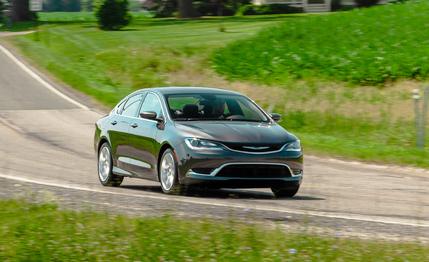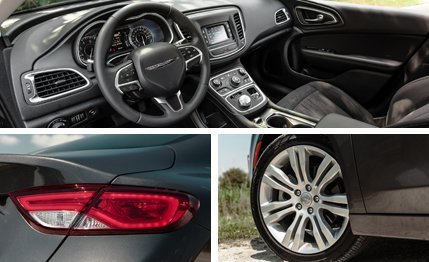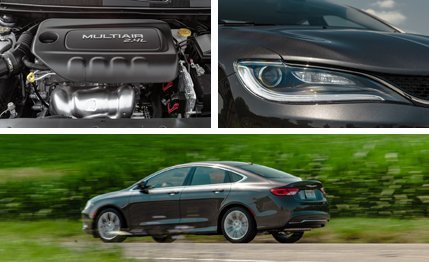
 Instrumented Test
Instrumented Test
The mission of the new-for-’15 Chrysler 200 is a challenging one: Represent the Fiat/Chrysler empire in the hotly contested mid-size-sedan segment. Although the basic recipe for success is hardly a secret, Chrysler’s previous Sebring/200 mid-sizers always felt undercooked. So when the 2015 200 made its debut at the 2014 Detroit auto show, hope sprung anew that the maker had finally found the right mix of ingredients that make cars such as the Honda Accord and the Mazda 6 so good.
Chrysler anticipates that 70 percent of the buyers for its new mid-size sedan will choose a four-cylinder powerplant, which is why the 2.4-liter Tigershark-equipped 200 is the focus of this test. (A 3.6-liter Pentastar V-6 is also available.) Our mid-level Limited test car arrived at our offices wearing subdued Granite Crystal metallic paint and a set of satin silver 18-inch aluminum wheels shod with 235/45 Bridgestone Ecopia EP422 tires.
Inside, the 200 Limited’s cabin provides a contemporary atmosphere befitting of its newly sleek exterior, avoiding discordant garnishes in favor of elegant minimalism. Basic black abounds, accented by thin strips of chrome breaking up surfaces and delineating control groups on the dash, doors, and console. Chrysler’s rotary gear selector shares space in the console with the electric parking brake and large round climate controls, all appropriately sized for easy, intuitive operation by the meaty paws of corn-fed North Americans. The instrument panel follows suit, placing two large and legible dials front and center, the space between them occupied by an information screen and segmented fuel-level and engine-temperature gauges. The layout might not be cutting edge, but you’ll rarely waste time looking for switchgear or controls. Our test car’s kit didn’t include Fiat/Chrysler’s now-ubiquitous 8.4-inch Uconnect screen, instead making do with a 5.0-inch version, which still provides Bluetooth connectivity but lacks navigation.


What the car did have was the $895 Convenience group (power front seats, backup camera, body-color power sideview mirrors with heat, leather-wrapped steering wheel, SiriusXM satellite radio); the $645 Comfort group (dual-zone automatic climate control, heat and A/C ducting for the rear seats, heated front seats, remote start, and auto-dimming rear-view mirror); and the aforementioned wheels ($595), our example wore an as-tested price of $26,385.
Producing 184 horsepower and 173 lb-ft of torque, the naturally aspirated 2.4-liter Tigershark engine is up to the task of hauling around the 200’s 3488 pounds, but not without registering a few noisy complaints. Peak torque comes on at 4600 rpm, right around the same spot where the sounds emanating from under the hood begin to get gruff. It’ll pull hard to the electronically limited 6500-rpm fuel cutoff, but the soundtrack leans to the death-metal side of the musical spectrum. Thankfully, the average buyer will rarely venture past 6000 rpm, aside from the occasional passing maneuver. With nine speeds to choose from in the ZF-designed automatic, there’s seldom a time when the engine is caught lumbering in the wrong ratio. The shifts are almost imperceptible, save for foot-down moments when it’ll skip a gear on the way to finding the optimal ratio. Sixty mph comes up in 8.4 seconds, the quarter-mile mark arriving in 16.6 with a trap speed of 85 mph. Compare those to the 7.4- and 15.9-second times recorded by an Accord EX-L Sport automatic we tested in a recent comparo with the Mazda 6, and then consider that the Chrysler is light years away from the Honda in high-rpm refinement. (As an additional comparison, our long-term 2013 Accord Sport equipped with a six-speed manual turned in 6.6- and 15.2-second figures.)
The 200 is far happier running errands and shuttling people about town than clipping apexes on a curvy back road. Swapping the efficiency-minded Ecopia tires for a set more concerned with grip than thrift, however, likely would improve the 200 in both environments. Still, our test driver coerced a surprising 0.81-g roadholding number from them, noting moderate understeer in the process. In town, it’s easy to make the tires squeal like the proverbial pig (apologies to Ned Beatty) by combining a dollop of accelerator with slightly turned steering wheel; under more restrained operation, the steering is reasonably quick but, as with most electrically boosted setups optimized for fuel economy, devoid of most road feel. Braking consumed 179 feet of pavement with no fade in repeated stops, putting it right in the meat of the class.


We achieved 27 mpg from the 200 in mixed driving. Good for the segment, that figure is of particular interest as it betters the 26 mpg we achieved in the smaller (8.4 inches shorter overall), slower, and 150-pound-lighter 2013 Dodge Dart Limited with the 1.4-liter Multiair turbo engine and six-speed dual-clutch automatic. No doubt, the 2.4-liter-powered Chrysler 200 just isn’t working as hard as the smaller turbo-powered Dart just to keep up with the flow of traffic, hence smaller throttle openings and better real-world fuel economy.
Although the new-from-the-ground-up 200 is a fully baked product, we can’t help but feel that drivers with sporting intentions will find it a little on the light side of hearty. The 200 doesn’t have the poor-man’s Bentley street presence of its larger 300 sidekick, either. In a segment flush with blue-ribbon entries that manage to mix four-door practicality with genuine fun-to-drive character, the 200 is still a few ingredients short of being top-shelf material.